
TECHNOLOGY RESEARCH
INSTITUTE FACILITIES
An ever-advancing research institute
TECHNOLOGY RESEARCH
INSTITUTE FACILITIES
Dynamics Laboratory
Tri-axial shaking table
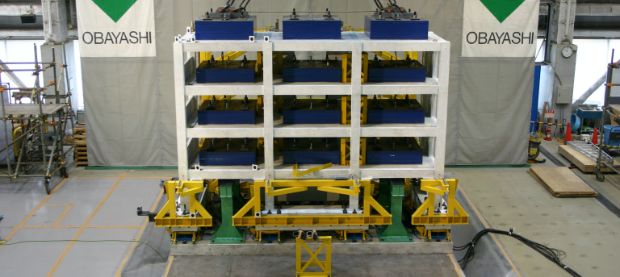
This is one of the highest-performance tri-axial shaking tables in Japan. With a large-size test model weighing up to 50 tons, the table accurately generates tri-axial vibrations from micro-earthquakes to those twice as large as the Hyogo-ken Nanbu Earthquake in 1995. It is used for technological development such as earthquake resistance, seismic isolation, and vibration control, as well as evaluation of safety.
Geotechnical centrifuge system
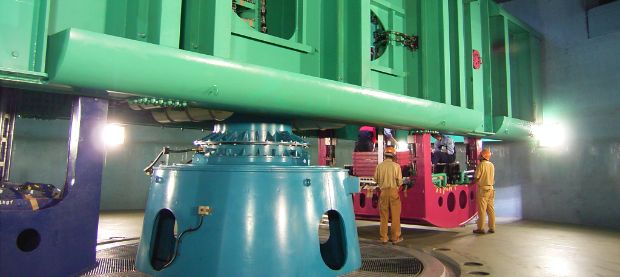
This is one of the world's largest experimental devices for geotechnical and seismic engineering. Earthquake-specific phenomena such as safety confirmation and liquefaction of underground structures are verified. With this apparatus, we precisely determine the strength, deformation, and hydraulic phenomena equivalent to those of real ground, by reproducing earth pressure and the external forces of a great earthquake or any other activities on the scaled model.
Large scale cyclic tri-axial testing apparatus
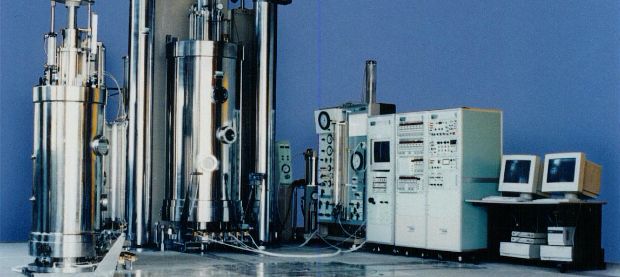
This testing apparatus simulates stress status of natural ground. Large grain size gravel, which is common earth material for reclamation, embankments, and so on can be tested using this apparatus. Both dynamic and static properties, such as strength, deformation, liquefaction, and the like are investigated.
Multi-purpose rock mass testing system
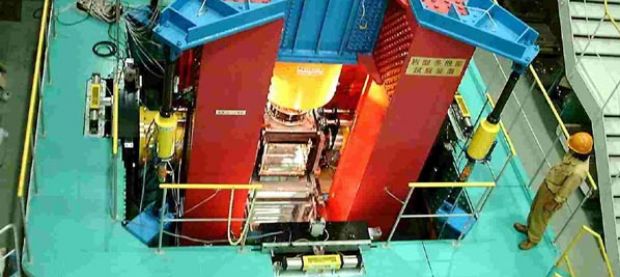
With this apparatus we investigate rock mass characteristics such as strength, deformability, and permeability using large-sized jointed rock blocks. The apparatus can also predict the behavior of rock structures by using physical models of underground caverns. It is used to evaluate underground structures in bedrock and bed-rock-based large structures.
Environmental Engineering Laboratory
Multipurpose wind tunnel

With the wind tunnel, we investigate the wind environment around high-rise buildings in urban areas and wind effects on structures. The photograph shows the inner section with dimensions of 3 m in width, and 3 m in height, where models experience a maximum wind velocity of 40 m per second. This is one of the largest facilities in the general contract industry in Japan. Effects such as the flow of wind around the building and the influence of wind on the building itself can be verified.
Multi-fan dynamic flow wind tunnel

We developed the world’s first experimental device by combining three uniquely characterized devices: a multi-fan wind tunnel device, using multiple blower fans that can generate various kinds of air flows such as shear flow; a tornado generator; and a downburst generator.
Acoustics testing facility


There are two reverberation rooms and one anechoic room, which which are used to measure sound insulation performance and sound absorption characteristics of building components.
Multipurpose Laboratory 1

This is the skeleton infill laboratory. With a highly flexible space design, we can respond to changing needs with the times. It has a multipurpose experiment space where various experiments can be flexibly conducted, and a large seismic table for dynamic experiments on the ground that can reproduce the movement of the ground during earthquakes such as liquefaction phenomena.


A workplace that brings out the highest levels of creativity in the people who work there

Before redevelopment, the layout spread out laboratories according to their respective fields of expertise, meaning that opportunities for interaction were scarce and communication between departments was lacking. The new main building therefore adopted a large, open workspace where researchers of all fields worked together in one place. Moreover, lines of movement within the building were devised in a way that would increase intellectual productivity and encourage communication through the effective arrangement of meeting and refreshment spaces. The open and unrestricted atrium space at this “research institute pioneering the future” also works to stimulate intellectual creativity in its researchers.

A building that will not sway in the event of an earthquake

The super-active vibration control technology “Laputa 2D” was applied to the Techno-Station building, thus realizing the world’s first building that does not sway during an earthquake.
When an earthquake occurs, Laputa 2D’s sensors installed in the building and ground detect tremors under the ground. A computer then instantly calculates the optimum force of control, triggering actuators to move the building in the opposite direction of the tremors in order to suppress any swaying. The application of such technology in a research setting has led to a sense of safety and security among the researchers.

Considerations toward wellness

Obayashi Corporation has been working on developing technology required for realizing what it calls “wellness architecture”—i.e., a means of building planning, operation, and management that makes comfort, wellness and well-being, and resilience a reality by encouraging a building’s users to engage in activities that foster a wellness culture and environmentally conscious behavior.
In November 2017, Techno-Station was awarded the Gold level under the WELL Building StandardTM (WELL Certification), an international building and interior environment evaluation standard that focuses on health and well-being. This was the first building in the world to receive certification for the project type, “New and Existing Buildings,” which involves evaluating an entire building on everything from design and construction to building operations.
To acquire WELL Certification, the interior and lighting environments were reevaluated from the perspective of wellness and well-being. Diverse elements such as circulation networks in offices, the surrounding natural environment, the ways in which people work, and even the cafeteria menu were placed under evaluation, and measures toward making these elements better comply with the standards were considered. As part of this effort, consideration was also given to easing tensions in the body, with standing desks being introduced. Techno-Station has been recognized as a cutting-edge building not only in terms of its earthquake resistance and energy conservation capabilities but also in terms of promoting wellness.

Energy saving using natural light from skylights

Controlling heat and light to create comfortable spaces
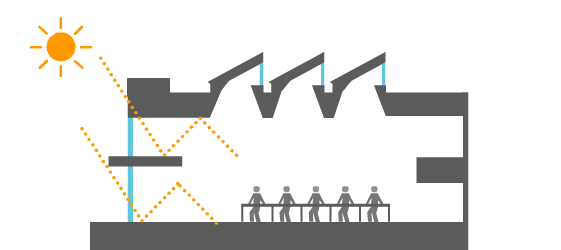
Harnessing wind as natural office ventilation
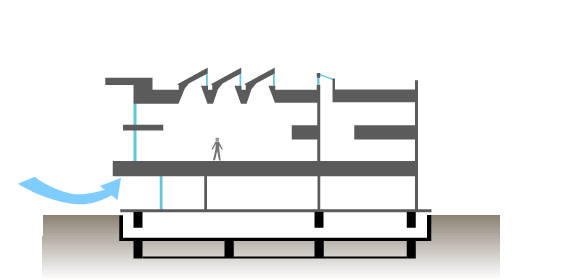
Efficiently using rainwater and groundwater
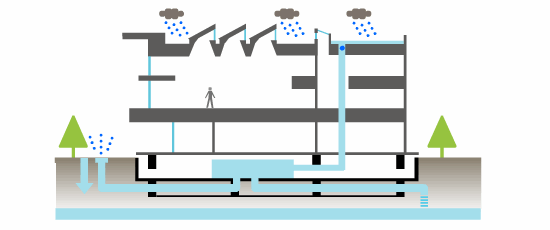
Air conditioning and lighting systems activated by IC tags
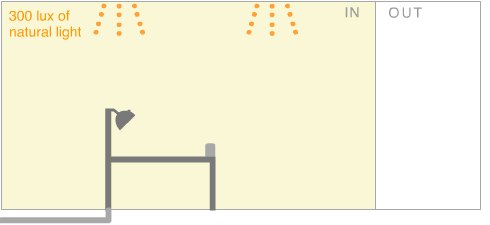
Both energy saving and comfort with personal air conditioning
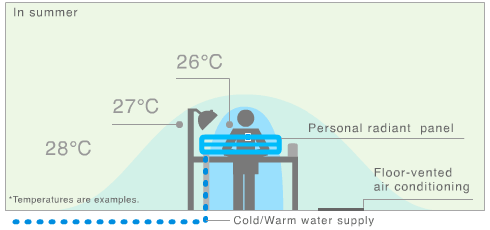
Using geothermal heat to reduce power consumption
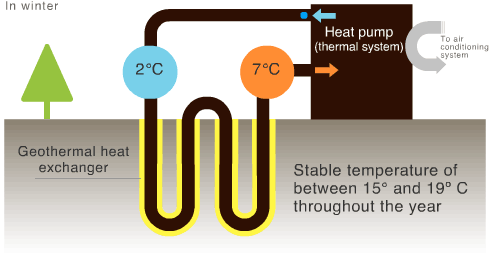
Switching to natural ventilation mode with the building’s eco indicators
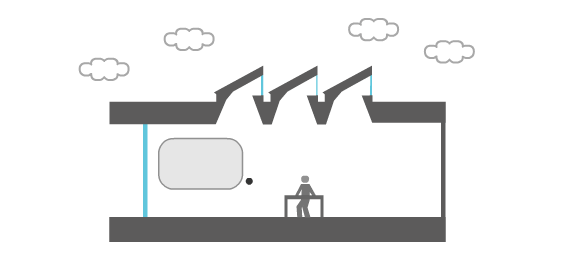
Energy saving and CO2 reduction can be checked at a glance
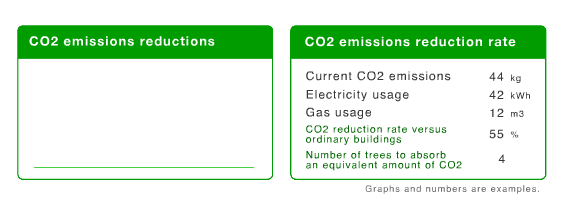
Electromagnetic Environment Laboratory

This is a facility for research of electromagnetic waves. We evaluate performance of materials in shielding or absorbing electromagnetic waves to control the electromagnetic environment which is created by smart phones, Wi-Fi, etc.
Multipurpose Laboratory 2

The concept of this facility is an open “fascinated” experimental space that visualizes technology. We conduct research on concrete materials and construction DX with the aim of being carbon neutral at an experimental facility for green innovation globalization.
Multipurpose artificial meteorological simulation chamber

This chamber simulates the world’s various meteorological conditions for research and development purposes to test the durability of materials in severe environments. The chamber consists of two sub-chambers. In testing, the following six types of climate conditions are combined and applied: high temperature, low temperature, rain, snowfall, solar radiation, and wind.
Vibration experience equipment

The equipment is used to test the seismic vibration of buildings, using various vibration control technologies and base isolation technologies, including Super Active Base Isolation System "Laputa 2D," and the seismic and wind vibration of super high-rise buildings. The equipment creates the opportunity for project participants to share their experiences regarding tolerance level of vibration.
Mobile plant for special types of concrete

This movable concrete mixing plant is equipped with a high performance mixer which produces full-size models using special concrete with various materials and different mixing proportions.
Fire Protection Engineering Laboratory

This facility is used to perform comprehensive verification of fire safety of buildings and civil engineering structures with various experimental equipment. We aim to develop new construction methods, improve performance fire resistance design technology, and improve the safety of deep underground spaces.

Structural Engineering Laboratory

This laboratory is used for experiments to verify the performance of buildings, bridges and other civil engineering structures by using large-sized models. The laboratory incorporates two huge reaction walls with dimensions of 12 m in height and 10 m in width and a maximum lateral loading capacity of 24,000 kN. In addition, with the multi-purpose test equipment and the bi-axial loading test equipment, we investigate structural performance of our vibration-control systems and various kinds of structures.

Materials & Chemical Engineering Laboratory

This laboratory is a sustainable laboratory that is highly functional, safe, and sustainable, and is friendly to people and the environment. In this laboratory, we chemically analyze a wide variety of materials in order to develop new construction material technologies for harmless products with high quality, and environmental technologies, such as soil and water remediation, which preserve and enhance environmental quality.

An ever-advancing research institute
Creation of New Main Building, Techno-Station
The Obayashi Technology Research Institute was established in 1965 in the city of Kiyose, Tokyo. Since then, the institute has been expanding and updating its facilities and equipment in consideration of the needs of society. In light of the innovations in information technology and changes in business environments between the 1990s and 2000s, the institute launched a redevelopment project in 2007 with the aim of transforming into a facility which would befit a “research institute pioneering the future.”

As the first phase of this redevelopment, the Multipurpose Laboratory 1 was completed together with the new main building, Techno-Station, in September 2010. Also, the former main building was converted into the Materials and Chemical Engineering Laboratory in April 2011. Techno-Station was built around three key concepts: the most advanced research environment, environment-friendliness, and safety and security features. The building has earned recognition as the culmination of Obayashi Corporation’s technological capabilities thus far, as exemplified by the numerous accolades it has received over the years. These include the Sustainable Building Award (awarded by the Minister of Land, Infrastructure, Transport and Tourism in February 2012), the Japan Federation of Construction Contractors’ BCS Prize (2013), and the Good Design Award (2011).
Phase 2 involved turning Techno-Station into a source ZEB1 (January 2014) and constructing the Multipurpose Laboratory 2 (February 2014). For phase 3, a Smart Energy System2 was installed at the institute in February 2015. Through these developments, a new environment could be created for the Technology Research Institute: a place for technological innovation, demonstration, and presentation.
Since then, the institute has continued to update its facilities, including renovating the Environmental Engineering Laboratory (September 2018).

*1Source ZEB: A building in which overall primary energy consumption during building operations is reduced to zero throughout the year with the use of renewable energy, etc.*2Smart Energy System:A system installed at the institute to demonstrate the technologies required for next-generation smart cities. Based on predictions of electric power supply and demand calculated using big data, the system reduces peak power usage and power demand by maximizing operations in large-capacity solar power generation and optimizing the real-time control of micro-combined power systems and large-scale storage batteries in response to an ever-shifting balance between power supply and demand. Also, thanks to the introduction of SCIM (Smart City Information Modeling), it is now possible to visualize the status of electrical power generation, storage, and conservation in real time.
Main Building Techno-Station and Technology Research Institute
This video is an introduction to the Technology Research Institute, which has always been advancing toward cutting edge research and technology development. Celebrating the Obayashi Corporation’s 130th anniversary, please join us in looking ahead to the continuous evolution of the “MAKE BEYOND” laboratory.